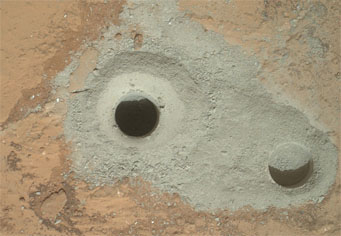Scientists and engineers are thrilled with results from NASA's beefy rover, Curiosity, which used its drill for the first time to make a clean, 2½-inch-deep hole in a Martian rock.

At center left is the first full-depth hole drilled on Mars by Curiosity. About 0.6 inch wide and 2.5 inches deep, it was made in a sedimentary rock called "John Klein". At right is a shallower hole created during a test of the drill two days earlier. Click here for a more detailed view.
NASA / JPL
That old carpenter's proverb, "Measure twice, cut once," is a mantra that the mission team for NASA's newest Mars rover is taking very much to heart. It's been six months since Curiosity landed on Mars inside Gale crater. But only on Friday, after a week of checks and test runs, did engineers command the beefy craft to drill deeply into a flat, vein-crossed rock on an outcrop of soft sediment.
Curiosity's drill ran for 400 seconds at 107 revolutions per minute. The resulting hole, 0.63 inch (1.6 cm) wide and 2.5 inches (6.4 cm) deep, created a doughnut of tailings distinctly lighter and more neutrally colored than the ruddy dust coating the rock's exterior. The team named the rock "John Klein" in memory of a former deputy project manager who died in 2011.

Ready, set, drill! This three-image sequence shows Curiosity's drill creating its first full-depth hole on February 8, 2013, the rover's 182nd Martian day of operations. Click here for a larger view of the scene.
NASA / JPL
As it spun, the drill head pushed rock powder along internal flutes and into small storage chambers. That dust will be sifted and sieved over the next few days and then analyzed to determine the composition of the rock's unweathered interior. Geochemists hope to find clay minerals and salts that were deposited long ago when the Martian environment was much warmer wetter than it is now.
Curiosity arrived at this patch of exposed bedrock in January, and the successful augering is the final checkoff in a series of equipment tests for the rover's complex systems and instruments that have been ongoing for months. Sampling of rock surfaces will be crucial to understand the evolution of the Martian environment once the rover eventually makes its way up among the layered deposits of Aeolis Mons ("Mount Sharp").
 1
1
Comments
Dr Sageer
February 11, 2013 at 9:04 am
The first man-made robotic experiment on a terrestrial planet other than Earth !
But where are the Martians ? Once lived !,
If so what kind of life forms primitive or advanced !!,
Are we alone in this Universe....Absolutely. ..No...!
There are evidence of Extra terrestrial's visit of Earth among ancient Civilizations like Maya, Inca ,of course ,Astec-Gilgamesh-an Astek ruler believed he was powered by Extra Terrestrials !.Even they Worshiped them as GOD !!!.
[email protected]
You must be logged in to post a comment.
You must be logged in to post a comment.